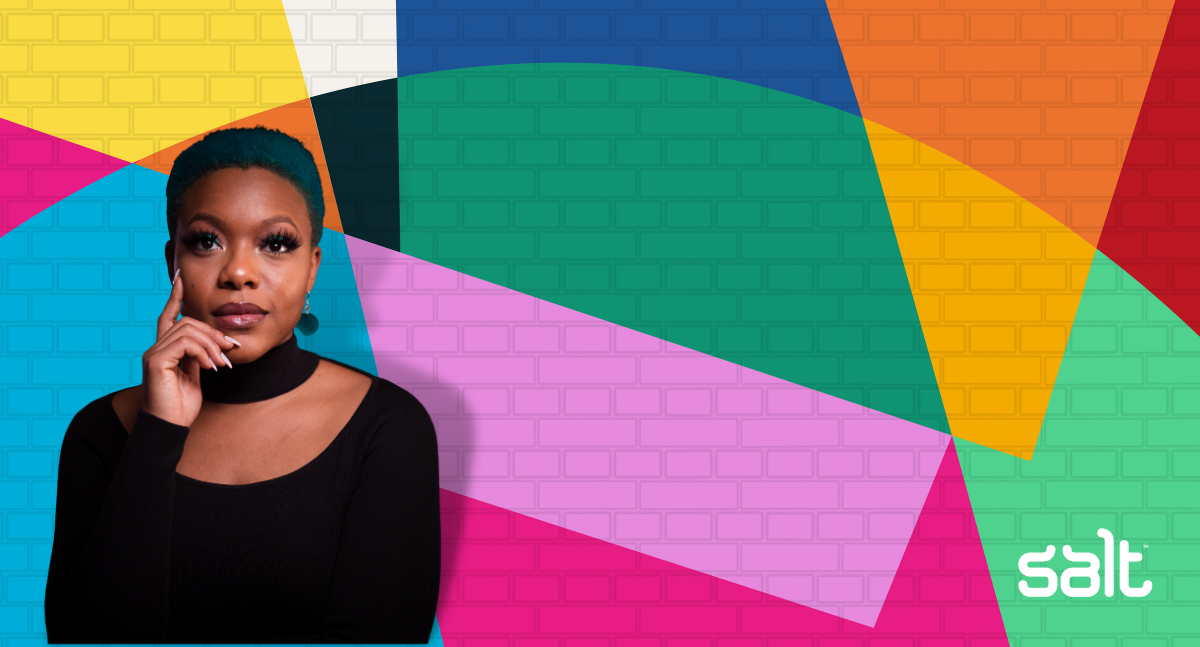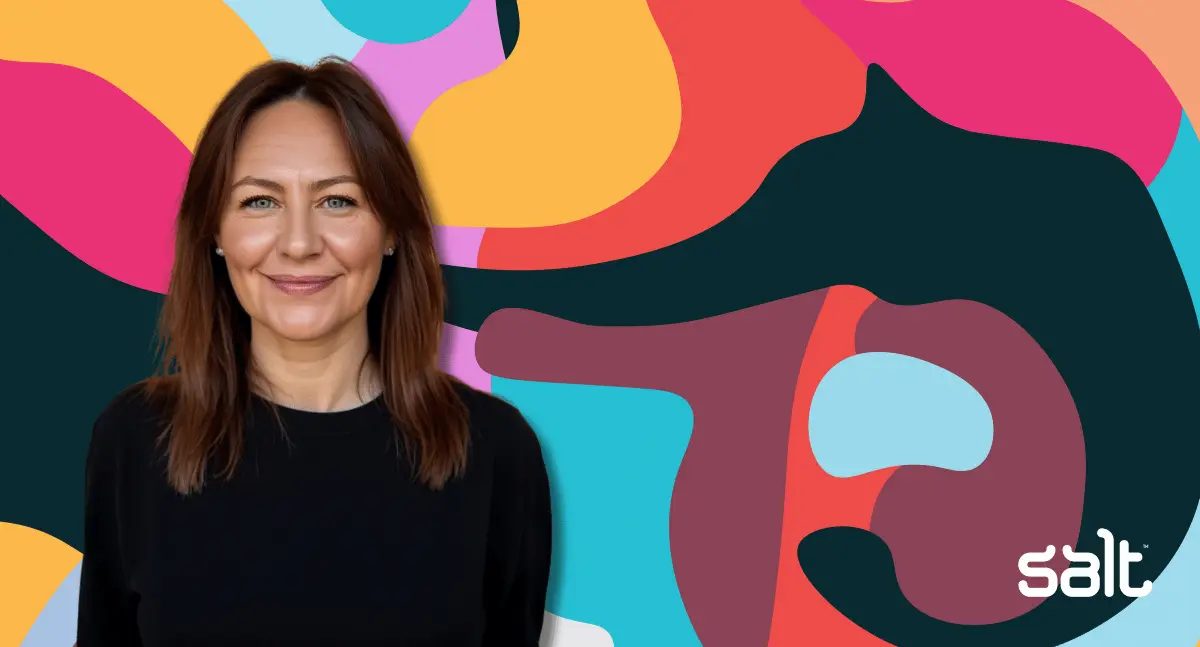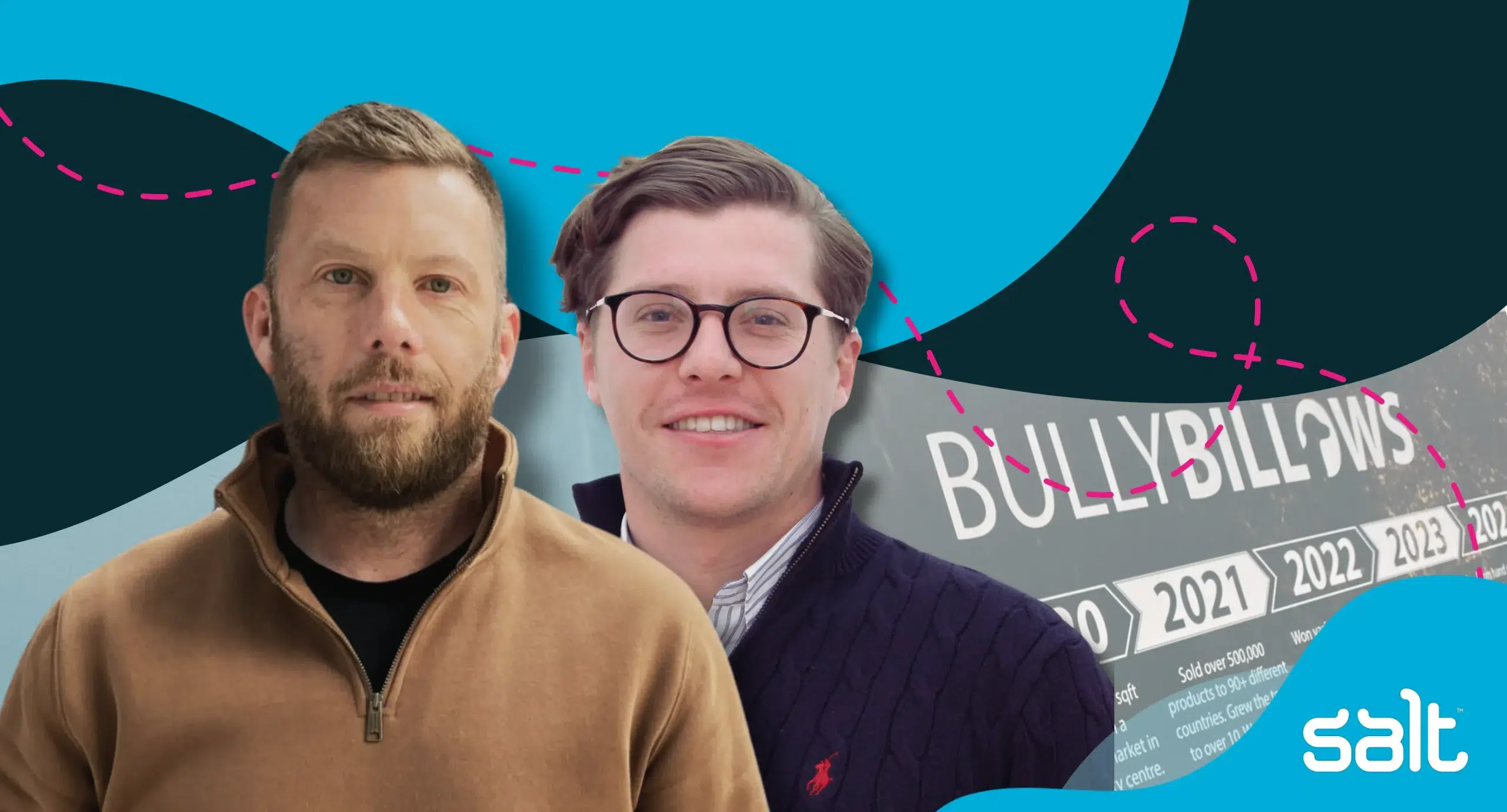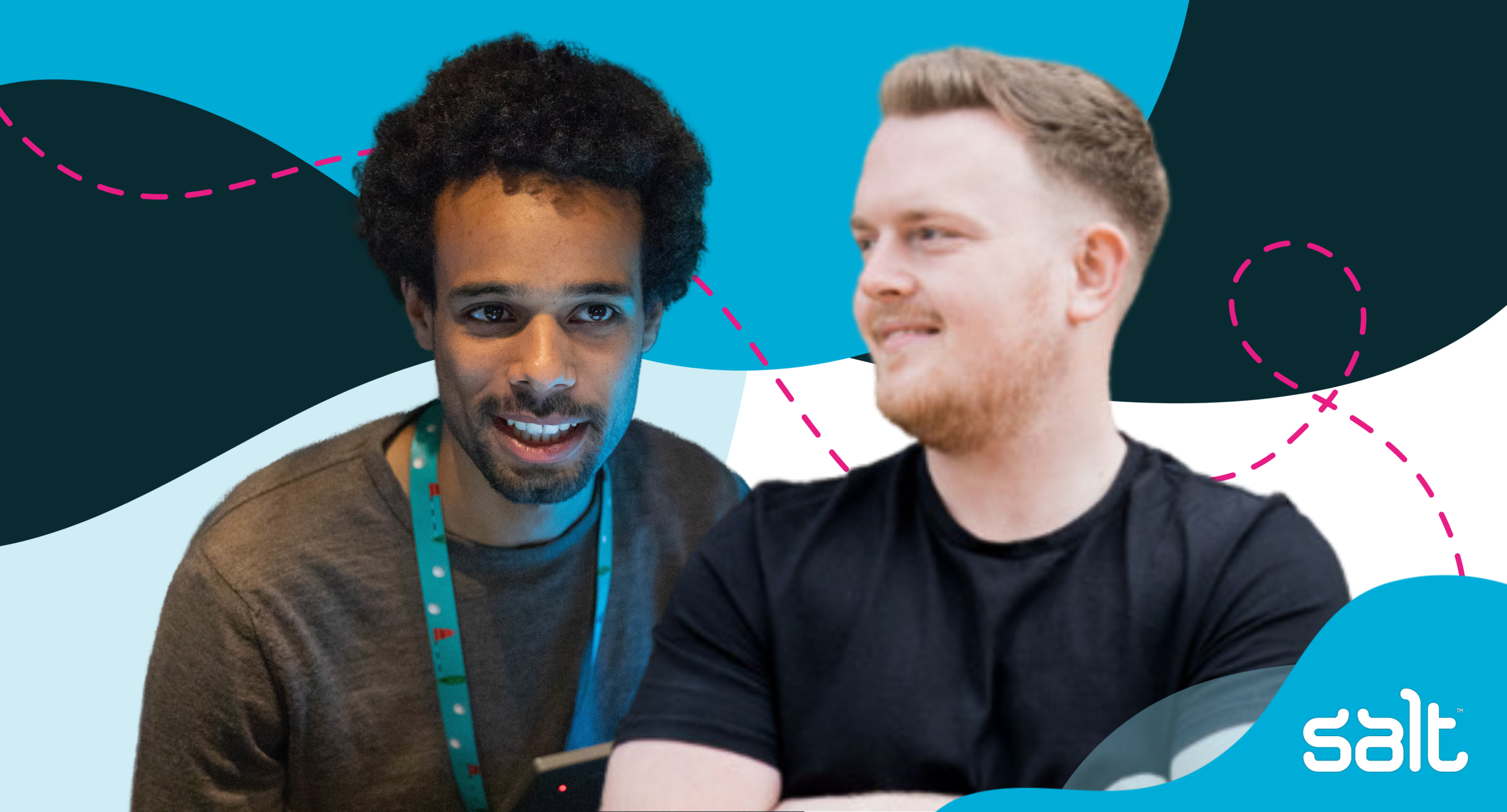
Traditional EDI isn’t working. Identity-based exclusion isn’t being addressed and businesses must change the way they operate – not just for their people but for the planet we share. Star Trek has a lot to teach us, inspiring Chelsea A. Jackson, MA MSc MPP, in her unique social justice approach to her consultancy clients. Her consultancy is called Equity Architecture (TM), and she shares her approach, advice and historical context with Salt in this interview – read or listen to learn more!
Introducing Chelsea:
My name’s Chelsea A. Jackson. I’m a rebel political scientist using social justice to change the business world.
I’m a social scientist by training and come from an academic background, writing and doing research around social issues and politics and how they affect our lives. I’m a speaker, writer podcast host, and consultant working with organizations to support them in ‘walking the talk’ and creating inclusive organisations fit for the future. I’m also an organizer and a feminist, and a part of the Cradle Community, a feminist collective focused on eliminating violence and promoting transformative justice.
What is wrong with traditional Equality Diversity Inclusion (EDI)?
The history of diversity and inclusion starts in the United States as a result of civil rights legislation. It comes into most companies and organizations between the 1970s and 1990s, and is coming out of legal expectations around not discriminating against people in the workplace based on their protected characteristics, so whether that’s race, gender, parental status, ethnicity, or ability.
The history of diversity and inclusion starts from a legal compliance perspective. It also starts from an anti-discriminatory perspective. Understanding those two things is really important to seeing why traditional diversity, equity, inclusion is still leaving so many gaps in terms of improving employee experience and actually addressing exclusion in the world of work.
What this approach does is focus on one identity at a time. It takes an additive approach to identity.
It says we need to look at gender, then we look at race, then we look at ability, then we look at social background, and then at neurodivergence. As though human beings could turn off one or more of those identities. Traditional EDI will always fall short because it doesn’t take an intersectional approach.
All human beings have every identity that we talk about within diversity and inclusion, but for some reason we talk about them as only women have a gender. Only Black and other global majority or people of colour have a race. Only people who have a disability have a level of ability.
The truth is, everyone who’s born and has a body and is a human being is affected by all of these identities, which means diversity and inclusion affects you.
So, this brings me to another issue with traditional diversity and inclusion, which is that most of the time it’s a stop gap or it’s in a siloed part of the organization.
When EDI is tucked away in HR, culture or some other operations perspective, rather being something that’s implemented and runs throughout the business it loses relevance and impact.
In an organisation walking the walk, social justice runs throughout the services, and products that it provides, the way that it treats its employees and makes decisions, all the way up to how its P & L is managed, including long-term investments and everyday decisions about how it moves forward.
Taking a horizontal approach to EDI is necessary to take into consideration other human beings, our identities and how they’re showing up in the workplace, as well as the histories of oppression and exclusion that are actually driving some of the outcomes that require diversity and inclusion in the first place.
An Equity Architect (TM) with a Star Trek vision
I do so many things that when I’m asked to describe what I do for a living, I must distil it down to three distinct identities.
I’m a nerd.
I’ve been really passionate about books since I learned to read at the age of three. And, for me, data and learning and making evidence-based decisions has always been the way that I’ve run my life.
As a nerd, I love Star Trek. For my vision of a world where your identity does not constrain your possibilities in life and your opportunities, I look to Star Trek as an example of how technology and social justice together create an equitable future where people are given what they need, can actually thrive, and create things that we can only dream of.
I’m a hippie.
This speaks to me being a feminist and an activist, and to my passion for racial justice.
I became a racial justice activist at around 15 or16 years old. My passion for other human beings on the planet.
I really believe in my heart of hearts that we are all connected to one another. And I believe that through my spirituality and through my connection to nature and to other people, I can use my gifts and skills and talents for the purpose of making the world a better place for all human beings to live in and for the progeny of our species to thrive in and for our planet to survive. I really take that seriously and it connects deeply to my spiritual practice.
I’m an activist and I’m an advocate.
I am very passionate about change and eliminating inequality, tackling unfairness, and really getting to the root of injustice and rooting it out. But I’m also passionate about building the foundations and the organizations, the institutions, the policies, the rules, the norms, all the things that we have to build in order to live in a world that does work well for everyone, and where your race makes no more difference to the course of your life than your eye colour.
That is the world that I want to live in, and so I’m really passionate about building that and holding myself and everyone around me and organizations I come into contact with accountable to attaining that vision.
Why the name Equity Architect (TM)?
It actually came from a desire to create a pithy job title for myself.
Every role that I’ve held in my career–from diversity consultant, racial equity program manager, to director of research, to racial equity consultant—none of these job titles ever quite encompassed all three of those identities: nerd, hippie and activist.
I began to think about what is it that I do? What is it that I’m passionate about doing? Building. But not the actual building as in constructing, but the design and coming up with the blueprints for: How do institutions should work? What is health and safety, in terms of psychological safety, going to require? When I think about social justice, what are the blueprints? What’s the foundation? What are the materials? What are the inputs? What are all the things that we need to bring in order to accomplish the goals that we’re looking for, which will ultimately be the beautiful building.
I’m talking about blueprints and designs and dimensions and project management and bringing in all these things and looking at strategy and developing how this will change over time, how it interacts within its outward environment. That sounds like what an architect does.
I remember looking at architecture firms and looking at their websites to try and understand how they describes themselves and the work that they do. And when I really came to it, I said, okay, wow, I am an architect. What is it that I’m designing, building? What’s my specialty? My focus on equity or giving everyone what they need according to where they are.
What is equity and how is it different from equality?
I get a lot of very interesting responses when I talk about equity because people have such different understandings of what it means. But it’s such a simple thing.
For example, I wear glasses. If everyone on planet Earth was given a pair of glasses that were my same prescription, that would be equality.
But everyone doesn’t need glasses that are my prescription. Everyone doesn’t need glasses at all, and many of the people who do need glasses don’t need my prescription. But glasses should still be available, right?
That’s equity. That’s saying, hey, everyone doesn’t have the same needs with their eyes. Not everyone’s not going to need glasses. Everyone doesn’t have the same prescription. But we still need to have these things in place for the people that do so that they can experience the world in the same way that people who don’t need glasses experience the world.
I’m building organizations that do this, that respond to the needs of human beings in our planet, that put people first. They still want to be successful organizations and bring in profit, but only want to do it in a way that’s actually viable, not just viable for the P and L, but viable for their employees, their stakeholders, their communities, their customers, and also our planet.
An army of Equity Architects (TM) building a better world
I didn’t want to just want to be one architect. I wanted to build a consultancy called Equity Architecture (TM) thatTM houses an army of consultants that can go out into the world and make it what we want it to be.
So many of us realize that the status quo isn’t working well for everyone, but very few of us are, at least in the diversity inclusion space, are directly focused on building and implementing what it would take to not only just slightly move the needle a little now, but actually get us towards the outcomes that we’re hoping for. An outcome where everyone can excel and succeed and, and thrive, not regardless of their background, but because of their background.
My company Equity Architecture (TM) is a management consultancy focused on helping leaders and organizations to solve organisational problems while embedding the values and mission they share with the world.
When organisations say they’re committed to equality, when they say they’re committed to net zero and us living on a habitable planet, we support them in implementation and strategy, product development and research, culture and employee management. Essentially to approach all the different elements of a successful organization while aligning with their values in a way they can be proud of.
Creating our own Star Trek world
Did I mention I was a nerd? If I did, let me emphasize that again.
The reason I love Star Trek so much is because I love sci-fi and futuristic worlds and technology and all those things, but mostly, because it gives me a glimpse of the possibilities for humanity.
So, in the Star Trek world, things like mass poverty and war are not plaguing the earth. Human beings are working together as a species and not only working together as a species, which means they’re looking at their commonality: We’re all human beings. We all share the planet earth. They have this human first perspective, but then they even take that and extend it out, out into the vast reaches of the universe and say, actually want to partner with Vulcans.
We want to make relationships with these different people. And even when we encounter challenges and we encounter new species or people who do things in ways that we don’t do them, we respect them and we want to get to know who they are. So, their rules around first contact when they meet a new alien species.
Star Trek has such beautiful analogies for social justice and the ways that we can, as human beings, treat each other in our planet better. It also asks us to look back and restore the harm that we’ve done to each other historically and to our planet in a way that allows us to look forward and thrive.
One of the first times a Black woman on television was in a leadership position was in an early Star Trek. You know that? In the 1970s, they cast a Black woman as the captain of a Starship. There weren’t other Black women in leading roles on 1970s television other than in Blacksploitation films and all-Black shows. But Star Trek had a Black woman, because it was about her being the best captain. It wasn’t about her skin colour or her gender. It was a real merit-based society.
Star Trek was breaking barriers in the real world because they were imagining what a future would look like. That is the exact ethos behind Equity Architecture (TM).
So yes, I do have have pie-in-the-sky, utopian visions about: what our earth could be, what humanity can experience, what our businesses can do to serve our communities, and how our economy can work to ensure every single person lives a wonderful and healthy life.
I believe those things are possible. And so, reaching for that utopian future must inform the way make decisions right here today: in advising our clients, in addressing disparities, in designing our codes of conduct & behavioural policies, in our supply chains & procurement policies. We must extend out and work with global majority and indigenous communities, looking at our sustainability / net zero / ESG commitments and partnering with the activists and climate protectors on the front lines who are dealing with the immediate effects of the climate crisis.
I believe that bridging the gap between these social change-makers (community members, groups, activists, individuals, start-ups) and the organizations that control the products and services of the global economy, is the only way the Star Trek vision comes true for humanity and for our planet.
How I work with clients to realise change
I’m very picky with my clients. And the reason I’m picky with my clients is because the motto of my brand is ‘Walk the Talk.’
I don’t want to work with clients who only want to ‘talk the talk’. I don’t want to work with clients who want a nice diversity statement. There are fantastic professionals who can support you in that. That’s not what I want to do.
I don’t want to help you do a press release until we’ve done the work that has made the sizable impact on the community that we’re talking about, and we’re doing a press release about the impact we’ve had on that.
Another slogan for Equity Architecture (TM) is “Our KPIs are human lives.” Our key performance indicators are the actual tangible impacts on people’s lives and their experiences. All of the fluff: the amount of engagements, likes or retweets, gold stars or awards for diverse employer of their year or happiest employer in the world… All of those things are fantastic, and I salute the professionals who work on those things. I’m not interested in doing that.
I’m not going to give you a gold star. I want to help you do the right thing when it’s hard. I want to help you make the tough decisions.
I want to be in the room with the CEO when he’s deciding to do layoffs. Why? Because I want to ensure the layoffs are not undermining the equity goals that we’ve been working on. I want to make sure that he’s considered all his options before he goes to layoff anyone.
When Equity Architecture is advising the CEO, mass layoffs would be considered our nuclear option. I’d be asking:
- Have we downsized our buildings?
- Have we reduced our workforce to completely hybrid or completely remote for six months so we can reduce our operating costs and we can transfer that flash cash flow so we can retain our staff?
- Have we gone and sold all our stock buybacks that we’ve bought in the past 24 months so we can re recover that cash flow and retain our staff?
- Have we reduced executive compensation and bonuses to come within a certain level of disparity with our entry level employees?
I want to be in the room with the decision makers when they’re making difficult decisions so that they can understand: we can’t continue to make short-term decisions based on the incentives that we have right now in the market, based on what we have right now in society. Because if we do, then 5 years from now our planet won’t exist in the way that we understand it now. We really must be honest about the fact that we cannot continue along with the status quo, even though that’s what market incentives are telling us to do.
People must be in the room who are willing to both imagine and challenge us to make a different choice and to look at all the levers that are actually at our disposal.
For me, client success is rooted in empowerment.
I don’t tell my clients what to do. and that’s very important because it’s one of the main reasons we get so much resistance in diversity and inclusion work.
The way I see it, If I have to tell you that the abysmal rates of retention for Black women in your organization is a problem, and that you need to do something about that, we should not be working together. You should be working with another professional who can help you understand why that’s a problem.
I want to work with a leader who knows it’s a problem, who sees it and is committed to eradicating it, but has no idea how to go about it.
When I come in, I can help you understand your problem. We can drill down and analyze and understand the factors that are driving this problem. Based on these factors, these are the potential actions you could take to rectify this problem, and this is the outcome that you would likely get from pursuing this course of action.
It’s about showing the client, if you have a very limited budget and you’re not prepared to put investment behind this, here are the activities and here’s the impact that they’ll have. It’s about presenting the client their options, supporting the client to make their own informed decision, and to equipping them and their staff to take the course of action they’ve decided to take.
So, it’s not about me coming in and fixing everything for them or doing all the work. No, it’s about us supporting you to do the work, because ultimately as a consultant I’m going to leave. This is something I find a contradictory part of the management consulting model, you come in as an expert and do everything for your client, deliver fantastically and then you leave them to their own devices again.
But for T.E.A, we come in with our expertise, a team of people who can support you to really understand your problem, what’s driving it, to make a sustainable decision on a course of action and to make a significant impact on the outcomes that you’re committed to.
The end goal is always using your organisational superpower to build something sustainable with a lasting impact. This approach for me is about educating, empowering and equipping my clients to scale and implement these principles as they grow and change.
Keep up with Chelsea A. Jackson
Follow me, Chelsea A. Jackson, the Equity Architect (TM), on LinkedIn to keep up with my latest content.
I’m hosting a new show, the Post Woke podcast, which has been out since February. Folks can go and check that out on wherever they listen to podcasts.
I am excited have been lead on the Racial and Ethnic Equity Action Agenda as part of the Global Alliance for Social Entrepreneurship with the World Economic Forum.
Keep an eye out for my upcoming research briefing with Echoing Green during Catalyst 2030’s Catalysing Change Week on Thursday 9 May.
Interested in the role equity plays in the business world now and in the future? Check out the World Economic Forum’s Schwab Foundation ‘Innovation for Equity’ report!
I have been dropping videos like Salary Justice and the Social Justice Redo, and you can also checkout my TED talk “ The Justice Bubble”.
Check out Equity Architecture (TM) for more information.
Reach out to me on any of my social media accounts at @mschelseann or @equityarchitect.


